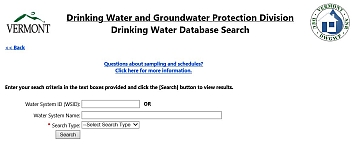All public water systems in Vermont must conduct required monitoring of their drinking water in accordance with state and federal regulations. Drinking water monitoring is necessary to ensure that public health is being adequately protected. Chemical Contaminants are largely regulated under the Chemical Contaminants Rule, or federal Phase II/V Rule.
Terms to know:
- Maximum Contaminant Level (MCL) – The maximum contaminant level is a legal limit set by the State or USEPA for the allowed amount of a substance to be present in public water systems. MCLs are based on a cost-benefit analysis and are legally enforceable standards. Depending on the contaminant, MCL compliance can be determined by a running annual average (RAA), average of initial and confirmation result, or by a single result.
- Vermont Health Advisory (VHA) – The concentration level of a substance in drinking water below which does not pose a public health risk or public health hazard, and for which there is no MCL established. VHAs are non-enforceable standards.
- Secondary Drinking Water Standard – A standard that is not a primary standard, but rather a guideline to assist public water systems in managing aesthetic concerns in their drinking water. This means in situations where the taste, odor, or appearance of the water deters persons served to not consume or discontinue use of provided drinking water. These standards may be applied in order to protect public health and welfare.
Additional definitions are referenced in the Vermont Water Supply Rule. Refer to Monitoring Schedule page and the Chemical Sampling Frequency Table for more specific monitoring information than what is available in this page.
Additionally, you can view a complete list of Table of Contaminants MCLs (from the Vermont Water Supply Rule Section 6.12)
Some water systems may be eligible for sampling waivers (for IOCs, VOCs and SOCs). In order to be considered for a waiver, the system needs to start with the waiver application.
Nitrate
All public drinking water systems must sample for nitrate annually. TNC systems may sample at any time during the year. Seasonal TNC systems are required to submit sample results while they are open and serving water to a public population. NTNC and Community systems must sample for nitrate according to the system's established monitoring schedule.
Sources of nitrate in drinking water include runoff from fertilizer use, leaking septic tanks or sewage, and erosion of natural deposits. Health concerns from nitrate include "blue baby syndrome" or methemoglobinemia. Infants under six months of age are the most susceptible to this concern as elevated nitrate levels render the infant's blood less able to carry oxygen. Confirmed sample results above the nitrate MCL require a Do Not Drink notice.
Samples for nitrate must be taken at the entry point to the distribution system, following all treatment and storage, and at or before the first tap/user in distribution.
Manganese
Manganese is a common mineral found in rocks, soil, groundwater, and some surface water in Vermont. It is a naturally-occurring component of most foods and is a trace mineral in our diets. Manganese is an essential metal required for many metabolic and cellular functions. Low amounts of manganese are essential to good health; however, elevated manganese exposure over a long time could harm the nervous system.
Manganese is currently regulated as a secondary contaminant due to aesthetic concerns. Manganese equal to or greater than 0.05 mg/L can lead to an unacceptable taste or staining of fixtures. When present, low levels of manganese can also build up within water system infrastructure causing future issues. Studies have shown potential health effects from consuming too much manganese. Because of these studies, VDH and the Division have worked together to establish a Health Advisory for manganese in drinking water. The Health Advisory for manganese is 0.300 mg/L.
Water systems with finished water monitoring results for manganese in excess of the health advisory level are required to complete a targeted “Do Not Drink” notice including the language below, and in accordance with the Division’s Do Not Drink policy.
USEPA has helpful manganese health effects information available.
Infants and children up to 1 year old should not consume water containing manganese over 0.300 mg/L because they have greater difficulty processing manganese than older children and adults. Special care should be taken to avoid making infant formula with water containing a manganese concentration above the health advisory level because formula is typically fortified with manganese.
Based on sampling result history, systems may need to sample for manganese once per month, once per quarter, once per year, or once every three years. While manganese is often part of the entire IOC monitoring suite, it can be "broken" out from the full IOC suite and treated separately from remaining IOCs. Samples for manganese must be taken at the entry point to the distribution system, following all treatment and storage and at or before the first user. Water systems on increased manganese monitoring are still eligible to apply for a monitoring waiver for remaining IOCs.
Manganese Guidance for Public Water Systems (and background)
Inorganic Compounds (IOCs)
Community Systems and NTNCs are routinely required to sample for IOCs. Baseline monitoring for surface water systems is once per year and for groundwater systems is once every three years. Based on the system's results, it may be possible to reduce IOC monitoring or to receive a sampling waiver for IOCs. IOCs can either be naturally occurring in drinking water or can result from contamination of a drinking water source due to human activities. If not naturally occurring, IOC contamination can result from industrial processes including metal manufacturing, metal refining and mining activity/runoff, explosives residues, improper waste disposal, fertilizers, chemical manufacturing, and glass manufacturing.
The full regulated list of IOCs (displayed as 'All Inorganic Chemicals' or CAIN on your schedule) includes 14 analytes:
- Antimony
- Arsenic
- Barium
- Beryllium
- Cadmium
- Chromium
- Cyanide
- Fluoride
- Iron
- Manganese
- Mercury
- Nickel
- Selenium
- Thallium
Compliance samples for IOCs must be taken at the entry point to the distribution system, following all treatment and storage and at or before the first tap/user in distribution.
Synthetic Organic Compounds (SOCs)
Community systems and NTNCs are routinely required to sample for SOCs. The frequency for monitoring is based on the system's previous sampling results, the size of the system, and whether the system has an updated Source Protection Plan. Surface water systems utilizing Lake Champlain as a water source are not eligible for SOC monitoring waivers; however, other systems may qualify for a monitoring waiver to either reduce the sampling frequency or eliminate the need to sample for SOCs based on vulnerabilities of the source. SOCs are not naturally occurring and while we rarely see contamination in Vermont, it would be the result of human activities. Water sources can become contaminated by SOCs from agricultural runoff or commercial and industrial processes. SOCs are mainly used as herbicides, pesticides, and some fuel additives.
The regulated list of SOCs includes 25 analytes:
- 1,2-Dibromo-3-Chloropropane (Dibromochloropropane)
- 2,4,5-TP (Silvex)
- 2,4-D (Agent Orange)
- Atrazine
- Benzo[a]pyrene
- BHC-Gamma (Lindane)
- Carbofuran
- Chlordane
- Di(2-ethylhexyl) Adipate
- Di(2-ethylhexyl) Phthalate
- Dinoseb
- Endrin
- Ethylene Dibromide (EDB)
- Heptachlor
- Heptachlor Epoxide
- Hexachlorobenzene
- Hexachlorocyclopentadiene
- Lasso (Alachlor)
- Methoxychlor
- Oxamyl (Vydate)
- Pentachlorophenol
- Picloram
- Simazine
- Total Polychlorinated Biphenyls (PCBs)
- Toxaphene
Compliance samples for SOCs must be taken at the entry point to the distribution system, following all treatment and storage and at or before the first tap/user in distribution.
Volatile Organic Compounds (VOCs)
Community systems and NTNCs are required to routinely sample for VOCs. Upon becoming a new system or permitting a new source, systems need to collect at least four (4) consecutive quarters of VOC samples. Based on the results of the sampling, the required frequency for future sampling is established. Most systems in Vermont sample for VOCs once every three years. A water system that sees VOC detections will need to monitor more frequently. VOCs are in the form of either chlorinated solvents or fuel components. Drinking water contamination may occur due to leaching from landfills, hazardous waste dumps or spills, industrial facilities, chemicals improperly cured or used during plumbing or storage tank work, fuel spills, or leaking fuel storage tanks.
The regulated list of VOCs includes 21 analytes:
- 1,1,1-Trichloroethane
- 1,1,2-Trichloroethane
- 1,1-Dichloroethylene
- 1,2,4-Trichlorobenzene
- 1,2-Dichloroethane
- 1,2-Dichloropropane
- Benzene
- Carbon Tetrachloride
- Chlorobenzene (Monochlorobenzene)
- Cis-1,2-Dichloroethylene
- Dichloromethane (Methylene Chloride)
- Ethylbenzene
- O-Dichlorobenzene
- P-Dichlorobenzene
- Styrene
- Tetrachloroethylene
- Toluene
- Trans-1,2-Dichloroethylene
- Trichloroethylene
- Vinyl Chloride (Chloroethene)
- Xylenes, Total
Compliance samples for VOCs must be taken at the entry point to the distribution system, following all treatment and storage and at or before the first tap/user in distribution.
Turbidity (surface water sources only)
In order to control microbial contaminants, especially Cryptosporidium, all systems that utilize surface water or groundwater under the direct influence of surface water (GWUDI) are required to routinely monitor turbidity. Turbidity monitoring helps to determine the adequacy of the treatment process and watershed control requirements. If a system suddenly experiences high finished water turbidity levels, it may mean a breakthrough in the treatment process which could then allow viruses, bacteria and/or parasites into the water system.
Secondary Contaminants
NTNC and Community systems may be required to monitor and comply with the secondary standards at the discretion of the DWGPD. These contaminants may either be naturally occurring or be the result of human activity.
The secondary contaminants include:
- Aluminum
- Chloride
- Color
- Copper
- Corrosivity (Langelier Index)
- Fluoride
- Foaming Agents
- Iron
- Manganese (SMCL and health advisory)
- Odor
- pH
- Silver
- Sodium
- Sulfate
- Total Dissolved Solids (TDS)
- Zinc
Some of these contaminants (such as Copper, and Fluoride) are also considered primary contaminants and are captured in the monitoring suites of sampling identified above.
Other Drinking Water Contaminants
Asbestos: Asbestos contamination is the result of using asbestos cement (also known as "transite" or "ac") pipes whereby the fibers of asbestos in the pipes degrade and enter the flow of water. Systems utilizing asbestos cement pipes are required to monitor for asbestos contamination in the distribution system at a point following the water's maximum residence time in the pipe in question. It is the Division’s preference that water systems make plans to replace all AC pipes.
For additional information about potential health effects for any of the contaminants listed above, visit the Vermont Department of Health’s website.
What do I do if my water contains elevated levels of these contaminants?
An exceedance of the MCL for any of the regulated chemical and radionuclide contaminants requires the water system to develop a plan and schedule to explore options which typically require the system to either treat or abandon the drinking water source. This plan will likely require hiring a consulting engineer and submittal of a new source permit application and/or construction permit for additional infrastructure. The water system must first obtain a permit from the Division when there is a change to the quality and/or quantity of the drinking water served before any work is done.
Additional drinking water contaminant information is available from the Vermont Department of Health’s website.


